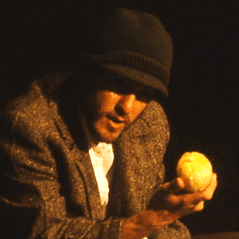
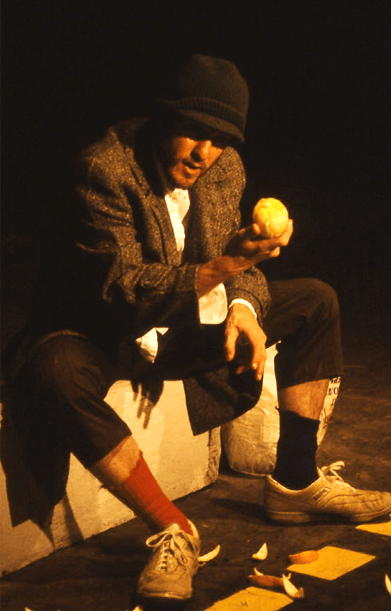
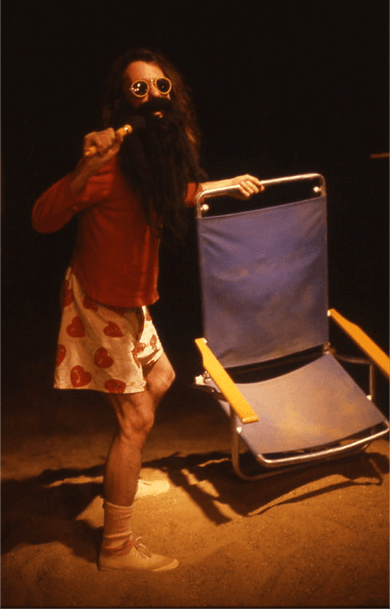
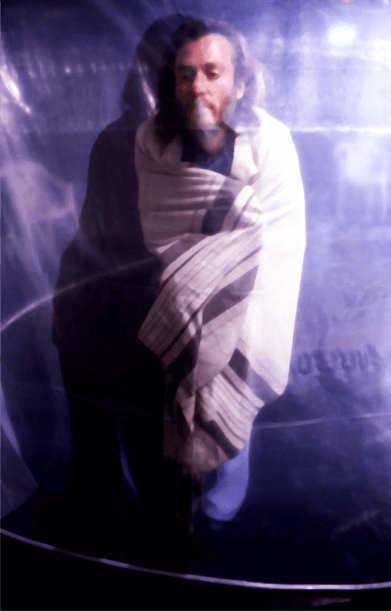
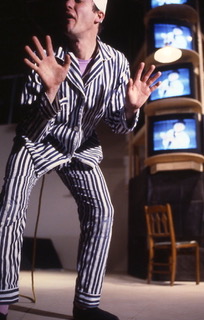
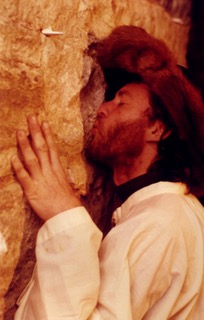
The Earth has undergone a series of violent and cataclysmic changes, as described in A Sound That Calls People From Afar. the narrator of A Series of Short Stories, grew up on Earth. he changes dimension and returns to Earth in order to view the devastation, whereupon he encounters a large pack of wolves. amongst them is a young boy whom the wolves raised from infancy, the son of A Sound That Calls People From Afar, the female protagonist of the play by the same name. eventually, the wolves become counterpoint to an Orange Haired Man who leads a band of angry white men across the alterred landscape.
The Native great grandchild of Rodrigues, one of the main characters from The Scent of the Land, Menton, survives the savage Great Swamp Massacre, whereupon he begins a lifelong journey that takes him west, far from the brutal forces of the Europeans, and later, the Americans whose westward movement invades the world Menton has chosen in the heartland of Turtle Island.
Why? why oh why? why do we do the things we do? what are we trying to do? to one another? ourselves? are we afraid? what are we afraid of ? is it for gain? what is it we’re trying to gain? what? that’s all i want to know. what is it? perhaps is it from fear? fear. i ask you, is it fear?
The strands left dangling at the end of the shape her bOdy makes, in The Scent of the Land, are woven into a complex story of early 17th century New Amsterdam which eventually became New York City, tying the loose threads with those of a small group of eccentrics living in the 20th century who have an abiding interest in the seeds being sown as Manahattoes makes the transition to Manhattan. time traveling, the seeds of capitalism, finding one’s voice in the midst of chaos, and the irrepressible desire for change, all converge.
In the beginning there is a dream. a boy lays aslumber, sleeping the sleep of a thousand years. a wOman enters the space of his sleep, kisses him, and a plants a seed withininin the ear of the boy, holding it within the soil of his consciousness. the seed germinates. from his thousand year sleep the boy named Ami awakens, rising, and in turn, planting the soles of his feet withininin the soil of the American continent that lays before him. the boy faces east. Across a vast sea, in the midst of an expansive and immeasurable desert, another wakens to his calling, and begins his journey. he faces west, toward the land promised him and his people. with each footfall these two travelers are brought closer to one another. A rich, mythopoetic language emerges as the shape her bOdy winds its way across the brawny American continent. in a station wagon, the cab of an eighteen wheel tractor trailer, a green boat-like Packard, by bicycle, and on foot, the reader is moved across the continent. Time Past and Time Present merge as the story rises from the topography, irresistible, potent, a great visual drama, part of the grand mythology of the American landscape etched by all those who have traversed the land, whose dreams have led them across the vast and sprawling continent.
A Sound That Calls People From Afar is the name of the young woman we find sitting atop a mountain of rubble at the beginning of the piece. she is the offspring of Menton, protagonist in the novel, I Am the Frontier, and the woman Menton met in Alaska who helped paddle and guide his canoe through the narrow straits along the Alaskan coast, and then arranged transport for him, via dogsled, to Nome and beyond, the end of the earth an Earth experiences a violent and massive cataclysm. the young woman has miraculously survived. is she the only survivor? a panoply of existential questions surface as the young woman engages with her situation.
The Man in a Flannel Shirt and A WOman, part of a single evening of performances inextricably tied much the way Ineluctable Modalities parts one and two were joined (see below); perhaps the way any man and woman are joined, two sides of the same coin, two peas in a pod. in this case the audience is separated from one another, and the peas performed simultaneously. after the first performance, the divided audience switches theatres to witness the missing pea. each character makes their appearance within the other piece through live and previously shot videotape. the performers are acutely aware of their separation, and seem to have an ineffable sense of the other’s presence. Two Peas in a Pod has never been produced.
Eva, EveryWoman, on her timeless journey in search of her female roots, connects herself with those who have come, and those women yet to come. extensive use of Greek dramatic forms: masks, puppets, lyrical and liturgical language, stylized movement, exotic gestures, rituals, and special vocal techniques. Eva, the EveryWoman; a three member female chorus; an elder crone on video tape; and a Shadow, are the primary characters. the Myth of Persephone is woven through the piece. three early segments of this project were performed at Three Quarters Below the Street, Pittsburgh Pennsylvania in the fall and winter of 1993. Duet was written by Mr. Wenger. the segments performed were directed by him as well.
An experimental theatrical conversation between text, music and video, structured as a travelogue, and based on the author’s peregrinations about the Sinai Peninsula. while Exodus has never been fully produced, an abbreviated version was performed at the Katz Theatre in Pittsburgh Pennsylvania, on the 23rd and 24th of January 1999.
A one person piece about a terrible mystery known as schizophrenia, an eponymous nod to Mr. Wenger’s brother David. the main character is loosely based on his life. the main character inhabits a clear, plastic, sphere-like bubble—a private planet; a mirror. the character is separated from himself; separated from the audience; and the audience is separated from one another—each member of the audience sits five to six feet from one another; only ten people were able to witness each performance. the text shifts between David’s parent’s home, the street, and various psychiatric wards. David struggles to create an intimately charged emotional and intellectual connection with each audience member. taped voices (parents, brother, friends, other schizophrenics, psychiatrists) and slides, add depth and poignancy. David teaches everyone a powerful and significant lesson about the emotional impact theatre can have on our lives. after each performance the audience remained to engage Mr. Wenger in dialogue and help release the intense emotions that surfaced during the performance. there was a need to find resolution for their feelings. written, directed, and performed by Mr. Wenger at Three Quarters Below the Street, Pittsburgh Pennsylvania in the spring of 1996.
The Passover Seder was deconstructed, then reconstructed from original material; excerpts from The Shalom Seders, and Haggadah, The Passover Story by Gerard Garouste and Marc-Alain Ouaknin; an adaptation of a Uitoto myth entitled “Was It Not an Illusion” and a segment from The Sunflower by Simon Wiesenthal. the script is based on the themes of separation, guilt, and forgiveness. powerfully evocative images: shaman-rabbi davenning, silently placing folded prayers in a stone wall; the ‘limping dance’ performed with rattle, while chanting the Uitoto myth of creation; Kaddish, performed as an old man in complete darkness; and from out of this darkness, the ghastly image of a young German soldier, his entire head and face wrapped in gauze. the youth tells a story of his participation in an horrendous wartime atrocity to a Jew who had been brought to his hospital room from a nearby concentration camp. at the end of his story he begs forgiveness from the Jew, but the Jew leaves in silence. the audience meanwhile, riveted to the young man’s story, has become the Jew. in the silence of the room, a question is put forth on tape (the voice of Mr. Wiesenthal), “What would you have done?” it poignantly dangles as the Rabbi finishes the Seder. as the audience eats the symbolic Passover foods, the Rabbi reminds them of the question. a remarkably spontaneous and profound dialogue resulted. first performed by Mr. Wenger in the spring 1995 at Three Quarters Below the Street, Pittsburgh Pennsylvania. parts were re-written and the piece reprised in the spring of 2002.
Reprise of earlier piece, re written, performed and directed by Mr. Wenger. exploration of a man’s sexuality and relationship to women as filtered thru a single event from the childhood of the performer. performer moves between a couch (objective thought) and a hair pile (subjective thought) thru a transit area (the world of experience), where he is engaged in a dialogue with himself, variously disguised on 4 linked video monitors housed within an 18’ totem, in an effort to come to terms with his past. slides and taped voices add mystery, texture and metaphor. highly cathartic. a rite of passage. the set is a series of platforms fashioned into a circle which slowly revolves through the course of the performance. the audience surrounds the set, ensconced in smaller environments (groups of eight), isolated from one another. via aural and visual stimuli, each group is drawn and intimately woven into the fabric of the performance. Pittsburgh Pennsylvania the spring of 1993.
A performance piece: 13 elements: 11 writers-readers; 1 musician; 1 visual artist; and a director, whose responsibility was to lead the audience pied piper fashion from location to location: 13 locations. each element revolved around the concept of Time. each element was timed to 13 minutes. all 13 elements were woven together in a randomly fashioned script, ambulating crossways around 13 locations, in a pattern of constantly changing configurations. the time signature for each location fostered idiosyncratic juxtapositions amongst the performances. each performance, at each location, was 13 minutes in length. Seven6=13 moved with peripatetic strides around the grounds of the Pittsburgh Center for the Arts, through its galleries, basement, in its elevator, to the hilarious finale in the parking lot. the past was re[present]ed on videotape by readings taped from galleries within the Center in the process of being hung. as they traveled from location to location, moving from the rambling lawn outside, to the galleries within the Center, Seven6 became a serendipitous study in Time. Mr. Wenger fashioned and designed Seven6 and was featured in the role of the Director. performed 7.6.92.
A male performer; a female performer; two separate spaces, separate monologues; two live interviewers, one male and one female; the audience aboard school buses. Ineluctable Modalities was performed at separate work(ing) locations in Pittsburgh Pennsylvania in the fall of 1991.
Modality part i
The audience was herded on a school bus which rode alongside the industrial area where proud steel mills once stood, en route to the first performance. on the bus a male interviewer inquired with the audience about work. upon their arrival, they were seated corporate boardroom style at long tables fashioned with pads, pencils and pitchers of water. the performing space was contained within a boxing ring. big business, manufacturing, food and boxing were the metaphors thru which a man’s relationship to the working world was explored. performer at a regal desk dangling from the ceiling by thick chains. written, directed and performed by Mr. Wenger.
Modality part ii
On the way to the second piece a female interviewer queried the audience about work. the second monologue was performed by a female actress. slides, video, a live trio, and audio tape were used to focus on the politics, socialization and sexuality surrounding our wonderful world of work. powerful image of female performer behind plaster cast of Venus de Milo applying make-up, while offering self-conscious comments about the application process. her glib commentary becomes a humorous extended metaphor on jurisprudence and the sexual politics of the work place. Modality part 11 was written and directed by Mr. Wenger.
Zed, Sam c. the Holy Ghost, a six person chorus and a six member band dressed in white atop a mountain. 13 songs, taped voices, exotic props and six tons of sand. extensive use of experimental slide imagery helped create a large environmental set. the audience sat in the last niteclub on the edge of the desert watching as The Summation of Oranges explored the relationships between the American landscape, the church, and our American values. this bit of social commentary was written and directed by Mr. Wenger, who also played zed. performances were in a large abandoned storefront in the East Liberty section of Pittsburgh, Pennsylvania in the spring of 1991.
Three performers, a chorus, a three piece mariachi band, taped sounds and slides. the American journey: time, evolution, the development of the landscape, and our social imperatives. an enormous set. the audience became America, sitting within one of three environments created to reflect the muscular American landscape: a lurid eastern city, the mountains of the west, and the prairie lands of the American breadbasket. written and directed by Mr. Wenger, who was also the featured performer. Quodlibet was performed in the old Brew House on the Southside of Pittsburgh Pennsylvania in the spring of 1990.
Solo performance piece, written, performed and directed by Mr. Wenger. each section of this quartet viewed work from a unique perspective. seminal piece for creative and experimental use of audio tape, slide imagery and the manner in which the performer worked separately from these elements, a process which fostered a very abstract working relationship between performer and media. overriding image: performer attached to harness pulling an enormous rock atop a cart outfitted as an automobile—around and around and around and around the rotunda of The North Carolina School of Design, Raleigh North Carolina in the late fall and early winter of 1980.
A solo performance, written, performed and directed by Mr. Wenger. an incident from childhood regarding a woman, forms the basis of this thriller. to satisfy his sense of loss, the performer, as detective and suspect, scrutinizes memories, feelings, images and ideas for clues about an obscure incident that occurred deep in childhood. performed in an off the beaten track apartment, Raleigh North Carolina, in the spring of 1980.
Writing as a process, the rituals of our everyday working world, the significance of place locally, globally and historically, and the rites of passage we make, all converge in this highly poetic script. the audience was placed in the middle of four large industrial wooden posts. a balcony allowed action to take place above, as well as around. laminated invitations attached to wooden stakes by colored surveying tape, were planted in the yards of the invitees. Opening Windows Passages was written and directed by Mr. Wenger. he also played the title role of the Poet. Opening Windows Passages was performed in the Antiques Warehouse on the edge of the R.R. tracks, Raleigh North Carolina the summer of 1979.
A diverse group of artists from various media gathered at an old farmhouse and created grid,ink. an experimental theatre company. Trash was the seminal piece written in a collaborative setting during the weekend retreats at the farmhouse. the script evolved from a series of improvisational tasks, games, exercises and rituals. an archetypal hunter, 2 punk rockers, a lost waif, a female sensualist, and a pair of tyvekkians converged upon the landscape. performed as part of the first annual ArtSplosure, Raleigh North Carolina, spring 1978.
Vox clamantis in deserto, a lone voice in the wilderness, is attributed to someone who expresses an idea or opinion that is not popular, or said individual is the sole person expressing this notion with the suggestion the idea is ignored. the line is from Isaiah 40:3 “The voice of him that crieth in the wilderness,” considered disruptive, and running against the grain of the culture, village, or nation. Voices in the Wilderness is a collection of stories about obscure, yet pivotal characters who have shaped the greater good in America and whose ethos resonates with their peculiar spirituality. the project aspires to create a series of theatrical works that probe the psyche of the American landscape and how various thinkers have embodied this language. Adriaen van der Donck is the first study and A-Dam the first piece.
Lone Wolf | ˌlōn ˈwo͝olf |noun, a very independent, and or solitary person: he is a lone wolf; that’s what he is. it’s what made him a successful ranger. his companion, likewise. her name is Tonto.
I began with the harrowing image of a mass exection of a group of women. as i explored the image, a sense about who these women were began to surface. female heroines, each and every one, thirteen Eves gathered around a table—a Passover table, the Last Supper—after their execution. a deeply spiritual undertone gripped me, charging me with a meticulous exploration of each character, their relationship to one another, and their roles in the evolution of the American landscape.
This piece is not about Adriaen van der Donck. perhaps the main character was once called by that name, but no longer associates with the name, or the personality of Herr van der Donck. the character in this piece is A-dam, the American Adam, first man, first in a line of radical independent thinkers whose lives have shaped this country even while they have never been embraced, at best, paid lip service. my intention has been to expose the ideas of van der Donck embedded in America’s effort to secede and fight for its independence from England and establish a democratic republic.
a particular way of looking at things
a very special sense of Time
to smell:
the birth of America: a mythology. seeds are planted. roots are placed into the soil of a land known as America. the Vikings; the Lenni Lenape; two cultures meet on the soft shore of the Atlantic. stories, film, music…an opera.
the seeds planted at the first millennium, six hundred years later, germinate. the evolution of America from the point of view of the land. the continent comes alive. more film; more music. poetry.
a locale, a location, the local: from the particular to the general; two people, a male and a female join. part iii is a dance for two performers: they come together, they separate, they return; they perform rituals; they each make a personal transformation. this piece is a rite of passage. in addressing the issue of place, one should begin with the relationship they have with themselves, locating themselves, so to speak, within their body, within the garden, upon the land, a land known as body.
an audience is taken on a journey up a mountain to the summit. along the path, during the journey, pause is taken, questions asked, and rituals performers. at the summit a modern version of the Lenni Lenape Big House ceremony is enacted. there are no performers; there are no observers; there is only we. this piece is designed to facilitate a group transformation.
a man lays upon a divan in the throes of Death. gathered around him are his closest male descendants—Isaac, Lincoln, Bush—they await Abraham’s blessing. the theatre space consists of two elliptically shaped performing areas, joined by a bridge, a corpus callosum, where separate action occurs. each eye is surrounded by audience members. in the antechamber it is eat, drink and be merry, in contrast to the sombre atmosphere of the death chamber. America, part five has never been produced.
Lead actor in Andres Tapia-Urzua’s video Terminal about terrorism.
The Seder, a theatrical telling
Exodus Without a Tour Guide, a travelogue
Lead actor in Matadero Karma by Andres Tapia-Urzua, a video about raising cattle in Chile.
Solos, Duos and Trio, a nite of words, music, and passion; a nite of cabaret
David, a documentary, a one person piece about a terrible mystery known as schizophrenia
As a member of the Ching Ching Ensemble, an international group of musicians and artists
Tongues, written by Sam Shepherd and Joe Chaikin
Dismembered.Remembered, part 11, reprise of earlier production
Seven6=13, a performance piece: 13 elements, 13 minutes, 13 locations, revolving around Time
Ineluctable Modality, part one the wonderful world of work
The Summation of Oranges, the last niteclub on the edge of the desert
Quodlibet, an exploration of the American journey: time, evolution of the landscape and our social imperatives
Operation Work: in progress, the topic of work from four unique perspectives
dismembered/remembered, a series of exposures, performer as detective and suspect, scrutinizing memories, feelings, images and ideas for clues about an obscure event
Opening Windows Passages, Mr. Wenger played the part of the Poet
Trash, an environmental theatre piece, Mr. Wenger played the part of the Hunter
Krapp’s Last Tape by Samuel Beckett, an evening of dinner and theatre
